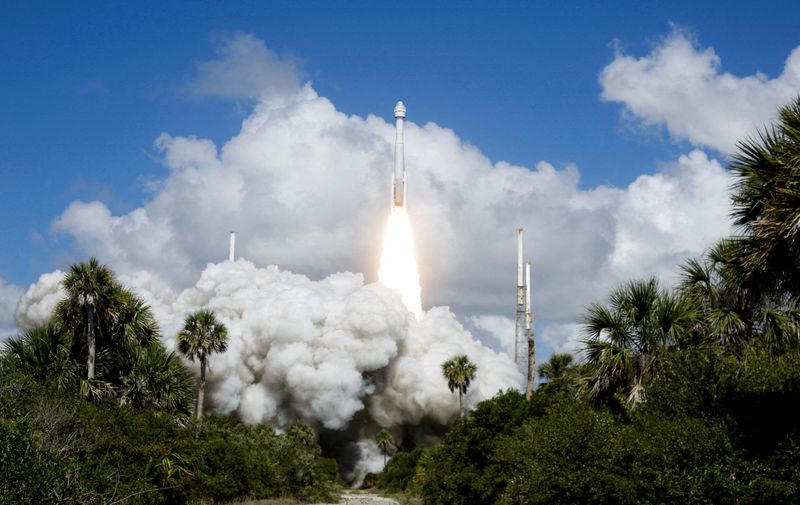By Joey Roulette
WASHINGTON (Reuters) - Boeing (NYSE:BA)'s Starliner spacecraft scored a crucial achievement last week with the delivery of two astronauts to the International Space Station, but problems encountered along its journey in space and more hurdles that lie ahead make the aerospace giant's goal toward routine missions a distant prospect.
The CST-100 Starliner capsule's first crewed docking with two astronauts to the International Space Station on Thursday marked a long-sought safety demonstration for two audiences: NASA, which wants a second U.S. spacecraft for rides to orbit, and the nascent market for private astronaut missions that is currently dominated by Elon Musk's SpaceX and its Crew Dragon capsule.
But before Boeing can chip away at SpaceX's grip on government and private orbital human spaceflight, its Starliner has several more test objectives to reach.
"It's a critical step, because if they can't successfully transport human beings to space, and safely return them, then they haven't proven what they need to do to conduct any missions," said Patricia Sanders, who until February was the longtime chair of NASA's Aerospace Safety Advisory Panel.
The crew - veteran astronauts and test pilots Butch Wilmore and Suni Williams - could return to Earth as soon as June 14 or stay as long as 45 days, NASA officials said.
During Starliner's 24-hour trek to reach the space station orbiting some 240 miles (386 km) above, the gumdrop-shaped spacecraft sprang four helium leaks and had five onboard thrusters go dead, delaying its ISS docking.
"Starliner made us work a little harder to get docked," NASA's commercial crew chief Steve Stich told a news conference Thursday night.
But some achievements include Wilmore taking manual control and testing steering, overall mission safety and the craft autonomously docked at the station. Over the next several days, Starliner will aim to show it can undock, maneuver more, then safely return to Earth.
Still, the helium leaks and propulsion failures, while no danger to astronauts, NASA officials said, are a nagging concern.
Boeing first found a leak of helium - used to add pressure to the thruster's propellants - while Starliner was on the ground last month, and NASA officials deemed it low-risk for flight. NASA officials said the thruster failures appeared similar to those found on Starliner's 2022 uncrewed test to the ISS.
"We don't quite understand why they're happening," Stich said.
Boeing has said it plans to redesign valves on Starliner's propulsion system after the company and NASA identified a flaw in 2022. And the company is receiving $5.5 million from NASA to study potentially redesigning Starliner's batteries, according to federal contract records.
"If they had something that required a design change that was going to be expensive and time-consuming, it may impact their business decision for going forward," Sanders said.
Starliner development challenges already have cost Boeing roughly $1.5 billion.
Starliner redesigns could drag out if Boeing has to involve its supply chain. In 2022, Boeing and its propulsion system supplier, L3 Harris' Aerojet Rocketdyne, feuded for months over which company was responsible for defects in Starliner's propulsion system valves and who would pay for the components' redesign, Reuters reported that year.
The company said it might implement that design change on a later flight, while a temporary workaround is in place.
Musk has boasted SpaceX as having an edge in being more vertically integrated.
A novel valve issue on SpaceX's Crew Dragon in 2019 caused one of its spacecraft to explode during an uncrewed ground test in 2019, prompting SpaceX to redesign the capsule's abort propulsion system. The redesigned system flew its first crew roughly a year later. And the company in 2021 redesigned Crew Dragon's toilet in less than two months.
"Fixing a design flaw or even something of concern like a battery is much, much easier in a vertically integrated company," said Abhi Tripathi, former SpaceX Crew Dragon mission director who was involved in the spacecraft's design changes.

It is not yet clear to NASA officials if the issues that occurred during Starliner's first crewed mission would warrant redesigns. NASA and Boeing will spend months reviewing mission data and examining the flight problems to determine if Starliner can be certified for routine flights.
"It's not a success until they safely return, and until we understand the implications of any anomalies that occurred during the mission," Sanders said.